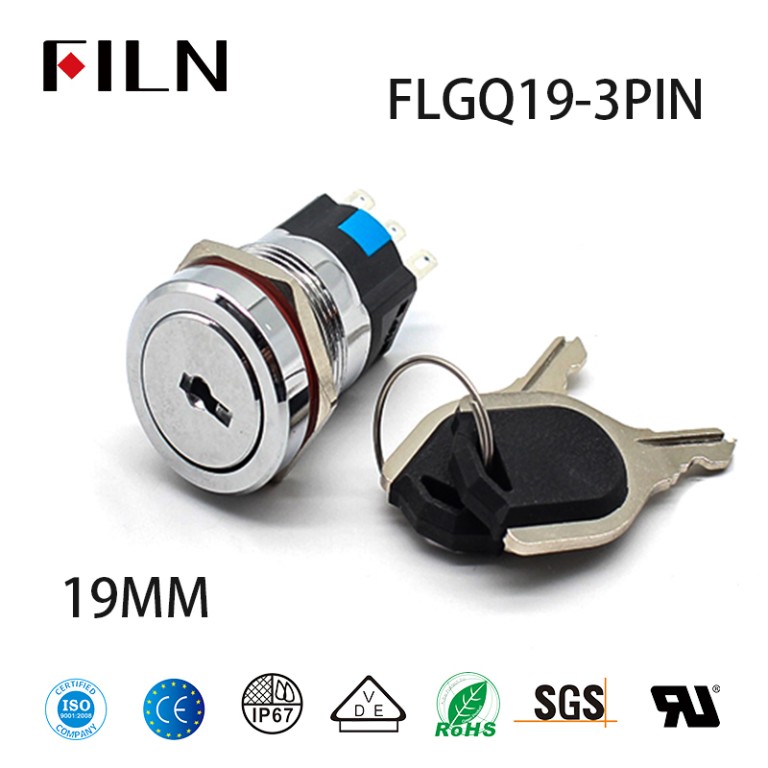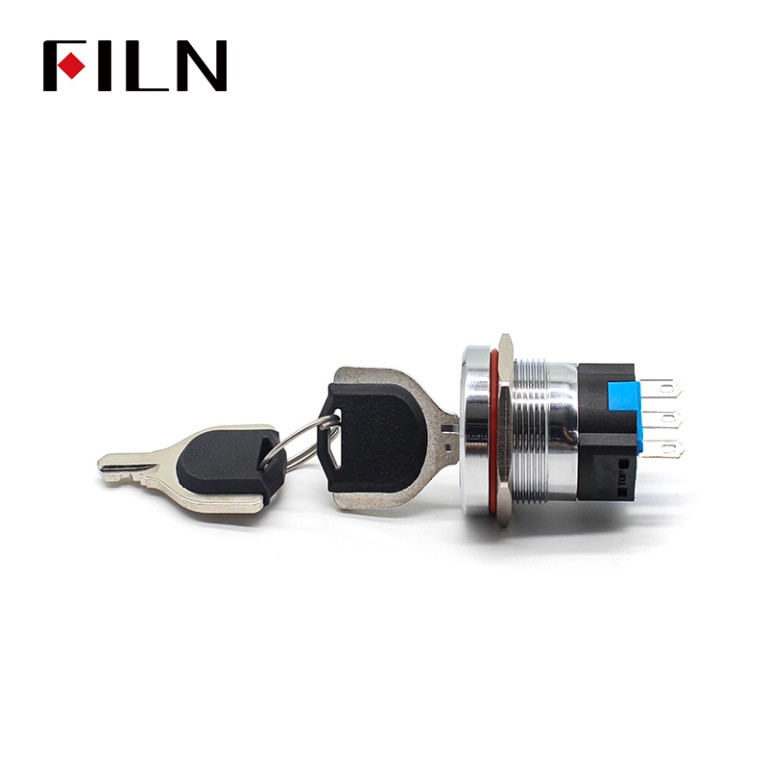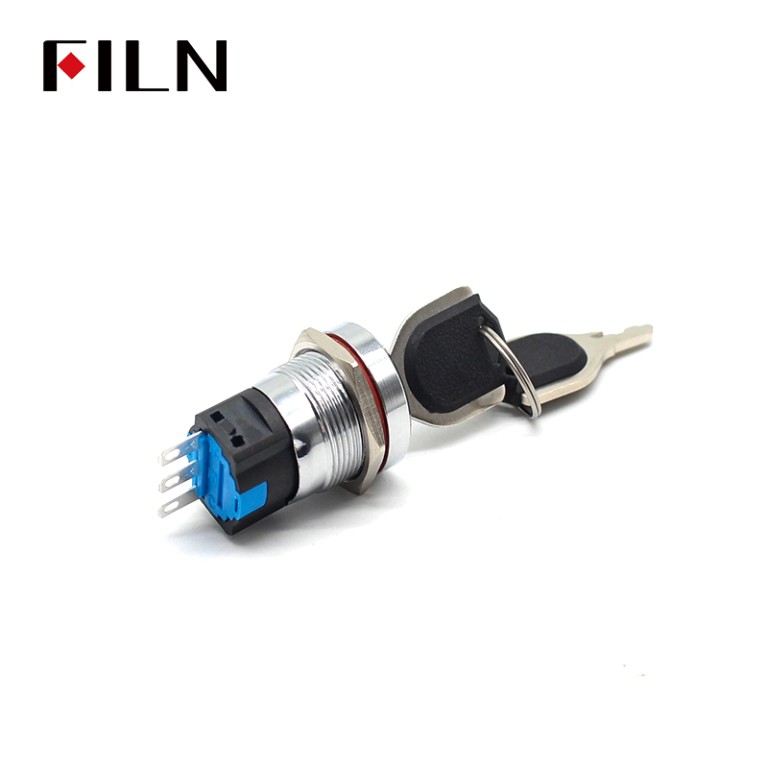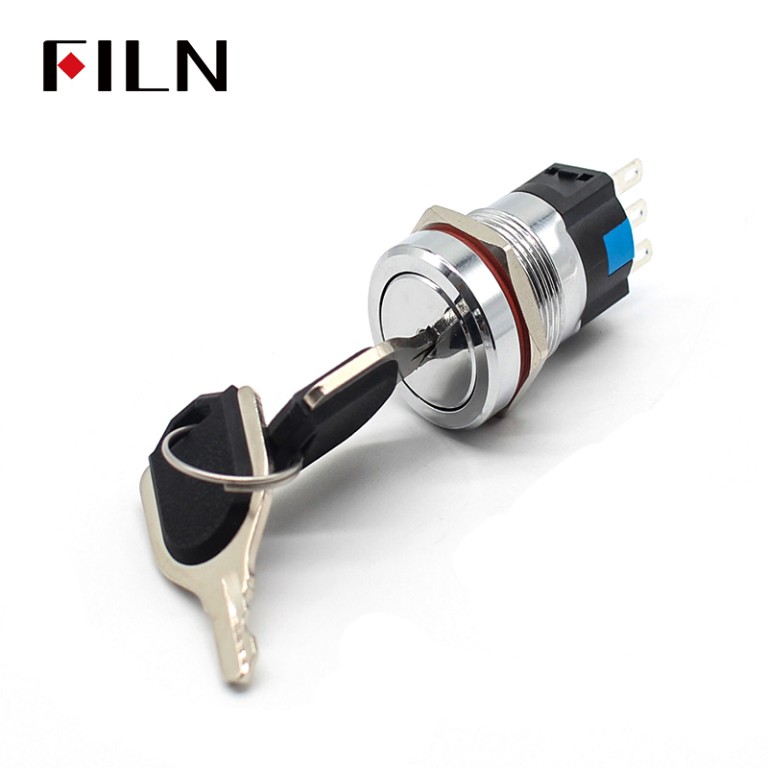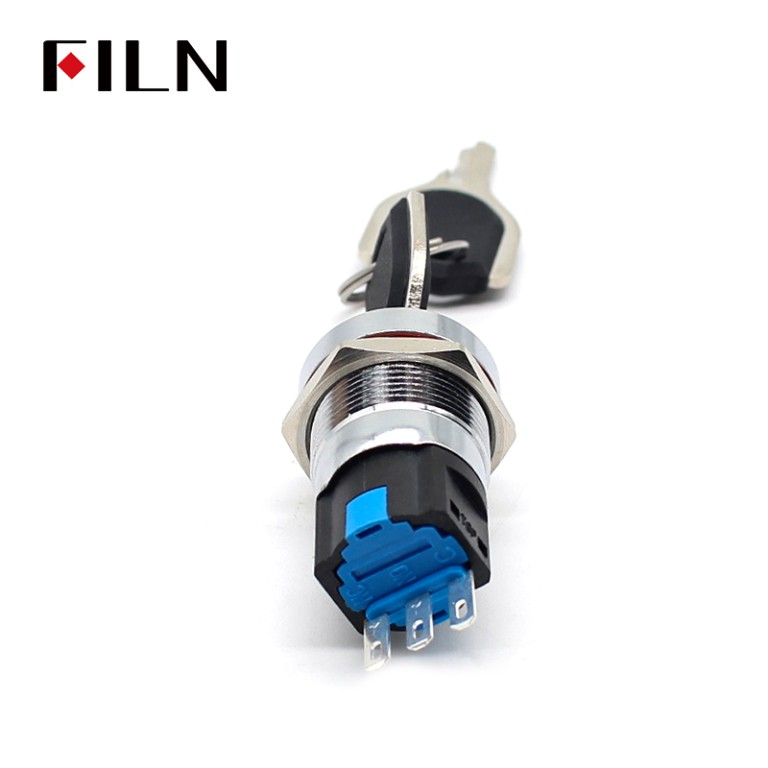Product Drawings:
The Complete Guide to On and Off Push Button Switches
- Name:On And Off Push Button Switch
- Model:GQ19
- Head Type:Flat Head
- Size:19mm
- Switching Functions:Momentary
- Contact Configuration:1NO
- Rated Voltage: 3mA~15A
- Voltage Options:12V-250V /DC
- Material:ABS plastic, Plastic
- Download Certification:CE, CCC, ROSH, UL
- Email:inquiry@cnylin.com.cn

Product Parameters:
| Product Name | GQ19 |
| Operation Type | Momentary |
| Light Voltage | DC 12V |
| Contact Type | 1NO |
| Material | Plastic |
| Mounting Hole Dia. | 19mm |
| Included Components | Micro Switch (optional, not included) |
How to wire a on and off push button switch with led?
In electrical circuits, how you wire a button electric switch can affect not only the operation of the switch itself but also connected devices. Here, we explain two different circuit configurations for a button electric switch, focusing on LED indicators and device operation.
The wiring way is as follows, the first step, the positive pole of the power is connected to the NO pin, the second step, connect the negative pole of power to the C pin of the switch.
Video of other button switch wiring
Customization Advantages of FILN on and off push button switch
The FILN on and off push button switch is a versatile product that can be customized according to the needs of different customers. This flexibility opens up an array of advantages for users, making it a sought-after component in various applications.
Why Customization is Important for on and off push button switch ?
Customization is not just a luxury but a necessity in the ever-competitive market. Manufacturers are under constant pressure to provide products that meet specific customer needs. In the case of the FILN on and off push button switch, customization has a significant impact in terms of functionality, aesthetics, and adaptability.
- Industry requirements differ: Different sectors have different requirements for push button switches. For example, the medical industry might require switches that are easily sterilizable, while the automotive industry may need switches that can withstand harsh conditions.
- Consumer Preferences: End-users may prefer specific symbols or lights that make the switches easier to use or identify, enhancing the user experience.
- Technological Advances: As technology progresses, the requirement for switches also changes. Customization ensures that the product remains relevant.

Customizable Button Symbols
One of the most prominent features that can be customized in a FILN on and off push button switch is the button symbol. Customers can opt for various light symbols depending on their specific needs.
- User Experience: A customized symbol can dramatically improve user experience by providing easy identification of the button’s function.
- Branding: Companies can also opt for symbols that align with their brand identity, ensuring consistency in product design.
- Regulatory Compliance: In some industries, there are specific symbols that are required by law to ensure safety and compliance.
Customizable Voltage Options
Another crucial aspect of customization is the voltage of the push button switch. FILN offers various voltage options, such as 110v push button switches, to cater to the varied needs of customers.
- Geographic Requirements: Different countries have different standard voltages. Custom voltage options allow for the global distribution of products.
- Device Compatibility: Customizable voltage ensures that the switches can be easily integrated into different systems without requiring additional components.
- Energy Efficiency: The ability to customize voltage can help in creating energy-efficient systems.
FILN’s commitment to customization offers not just product variety but also competitive advantage. Whether it’s custom symbols, voltages, or connectors, the on and off push button switch can be tailored to meet the unique demands of your project, making it a smart choice for a multitude of applications.
Related products:
Table of Contents
1.What are On and Off Push Button Switches?
On and off push button switches are simple electrical mechanisms that facilitate the flow of electrical current when pressed and interrupt the flow when released. This type of switch is often found in industrial setups, home automation, and various consumer electronic devices. The core concept is simple: a single button controls the on and off state of a circuit. They come in different variants like push button on/off switch 12v, push button on/off switch 120v, and even specialized versions like industrial push button on/off switches.
User Perspective
Users often find these switches user-friendly and intuitive to operate. The tactile feel and the immediate response offer a good user experience, making these switches common in consumer electronics and household appliances.
Manufacturer Perspective
From a manufacturer’s perspective, these switches are cost-effective, easy to produce, and integrate into different designs. They can be customized with additional features like LED indicators or waterproofing for specific applications.
Expert Perspective
Electrical engineers and experts appreciate the reliability and versatility of these switches. They can be integrated into complex systems and can also be modified for specific roles such as emergency shutdowns or system resets.
2.How do On and Off Push Button Switches Work?
The working principle behind an on and off push button switch is fairly straightforward. When the button is pressed, the internal mechanism either closes or opens an electrical circuit, allowing the current to flow or stop.
Mechanical Aspect
Mechanically, these switches contain a spring-loaded button that moves an internal contact. When pressed, this internal contact completes the electrical circuit.
Electrical Aspect
Electrically, the switch can either be “normally open” or “normally closed,” meaning that the default state can either allow the electrical flow or block it. This makes them versatile for different applications.
Technological Aspect
In more technologically advanced versions, these switches may come with additional features like LED indicators or even digital interfaces, which can offer visual cues to indicate the switch’s state. For more on this, refer to How does a push button switch work?
Wiring an on and off push button switch is a straightforward process that requires a basic understanding of electrical circuits. Typically, you would need wires, a soldering iron, and the switch itself.
DIY Enthusiasts
For DIY enthusiasts, wiring these switches offers a simple and rewarding project. The necessary components are easily available, and the wiring diagram is generally uncomplicated.
Professional Installation
In a professional setting, electricians use standardized wiring protocols to ensure safety and reliability. The wiring may include additional elements like a relay or a fuse for added protection.
Learning Resources
Detailed guides and tutorials are widely available for those who are new to wiring these switches. For a comprehensive guide on wiring, you can visit How to wire a push button switch.
3.What is the Difference Between Push Button On/Off Switch 12v and 120v?
Push button on/off switches come in various voltage ratings, the most common of which are 12v and 120v. Understanding the difference between these two can help you make an informed decision when choosing a switch for your project or installation.
Voltage Requirement
The most obvious difference is in voltage requirements. A 12v switch is ideal for low-voltage applications such as automotive installations or portable devices. On the other hand, a 120v switch is suited for household and industrial applications where higher voltage is required.
Application Scenarios
A 12v switch is often used in car dashboards, boats, or battery-operated devices. A 120v switch, however, is used in home appliances, industrial machines, and some types of commercial equipment.
Technical Specifications
The materials used in the switch may differ based on voltage ratings. Higher voltage switches generally require more robust components to handle the increased electrical load. For more information, check out push button switch 12v.
4.What are the Features of an On/Off Push Button Switch Circuit?
The circuitry of an on/off push button switch can range from very simple to somewhat complex, depending on its intended application and any additional features it may possess, such as a built-in LED indicator or waterproof capabilities.
Simplicity
The most basic circuits are incredibly simple, involving little more than the switch itself and connections for power and ground.
Additional Features
More advanced circuits might include additional components like resistors, diodes, or even microcontrollers for enhanced functionality. For example, some switches come with an in-built LED, requiring additional circuit considerations.
Circuit Diagrams
Various circuit diagrams are available to guide both beginners and professionals in setting up these switches. To learn how to connect one, you can read How to connect a push button switch.
5.How are on and off push button switch with LED Different?
Switches equipped with LEDs offer additional visual indicators to signify whether the switch is on or off. These LEDs are often integrated into the button itself or positioned closely nearby.
Visual Cues
The LED provides an immediate visual cue, making it easier for users to determine the switch’s status without having to rely solely on the device it controls.
Electrical Requirements
The LED element usually requires additional electrical components, such as a resistor to limit current or a diode for polarity protection.
Wide Applications
These types of switches are popular in various applications, ranging from household devices to industrial machinery, where a visual status indicator can offer significant advantages.
6.Are On/Off Push Button Switches Waterproof?
Waterproofing is an essential feature for switches that are exposed to the elements or used in environments where they might come into contact with liquids. Waterproof on/off push button switches are specially designed to withstand such conditions.
IP Rating
One common way to identify the waterproof capabilities of these switches is by checking their IP (Ingress Protection) rating. An IP67 rating, for example, would mean the switch is dust-tight and can withstand brief immersion in water.
Material Choices
The materials used in waterproof switches often differ from standard switches. They might include rubber seals or gaskets to prevent water ingress, and the casing might be made of more durable materials like stainless steel.
Applications
These types of switches are commonly used in outdoor settings, marine applications, or industries like food processing where they might be exposed to water or other liquids. For more information on waterproof switches, you can refer to push button on/off switch waterproof.
7.What are the Types of Industrial On/Off Push Button Switches?
Industrial settings often require specialized switches that can handle higher voltages, mechanical stresses, or specific environmental conditions. Industrial on/off push button switches are designed for these requirements.
Heavy-Duty Components
These switches usually contain heavy-duty components capable of handling higher electrical loads. They also come in more robust casings to resist mechanical wear and tear.
Special Features
Some industrial switches come with added safety features, such as lockouts to prevent unauthorized use or emergency stop functions.
Certification
These switches often require certifications like UL, CE, or RoHS to meet safety and quality standards within industrial applications. For additional details, check out industrial push button on/off switch.
8.What Symbols Are Used for On/Off Push Button Switches?
Symbols play a crucial role in conveying the function of switches to users. On/off button switch symbols usually include a line and circle to indicate the ‘on’ and ‘off’ states.
International Symbols
These symbols are internationally recognized and are used universally for all types of switches. They provide an easy way to identify the switch function regardless of language barriers.
Visual Design
Sometimes, these symbols are color-coded or come with additional design elements to make it easier to understand their function at a glance. For an in-depth look at on/off switch symbols, refer to on/off switch symbol.
9.How Can I Install an On/Off Push Button Switch?
Installation of an on/off push button switch varies by application, but the basic steps involve securing the switch in a predefined cutout, connecting the wires, and testing the operation.
Tools Required
Generally, a screwdriver, wire strippers, and a multimeter are the essential tools required for installation.
Safety Precautions
It’s crucial to follow safety guidelines such as disconnecting the power supply before starting the installation to avoid electrical shocks.
Installation Guide
Step-by-step guides and tutorials can provide valuable assistance for those who are new to this. For a detailed guide, check How is the push button switch wired?.
10.What Is the Functionality of a 20A Push Button On/Off Switch?
When you need a switch capable of handling higher currents, a 20A on/off push button switch might be the ideal choice. These are typically used in applications that require more robust performance.
Higher Current Handling
The standout feature of a 20A switch is its ability to handle higher currents, making it suitable for industrial applications or heavy-duty machinery.
Durable Build
These switches are often built to be more rugged and durable, capable of withstanding not just higher electrical loads but also more challenging environmental conditions.
Safety Compliance
Switches rated for higher currents often come with additional safety features and will typically have undergone rigorous testing to ensure they meet specific safety standards. If you’re looking for a 20A switch, you can check out 20A push button switch.
11.How Do Momentary Push Button Switches Differ from On/Off Push Button Switches?
Momentary and on/off push button switches serve different functionalities and are suited for different types of applications.
Operational Mechanism
A momentary push button switch only closes the circuit when the button is pressed and opens it once it’s released. On the other hand, an on/off push button switch maintains its state until it’s actuated again.
Applications
Momentary switches are often used in situations requiring momentary input, such as a doorbell or computer keyboard. On/off switches are commonly found in applications where a continuous state change is needed, like turning a device on or off.
Varieties
There are also hybrid switches that combine both functionalities, allowing users to select between momentary and sustained operation. To know more about momentary switches, visit momentary car push button ignition switch.
12.Are There Non-Illuminated Push Button On/Off Switches?
Yes, there are non-illuminated push button on/off switches that serve basic functions without any integrated lighting or LED indicators.
Basic Functionality
These are straightforward switches with no additional features like LEDs. They are used in numerous applications where illumination is not necessary or even desirable.
Cost-Effectiveness
Being less complex, these switches are generally more cost-effective than their illuminated counterparts, making them a good choice for projects on a tight budget.
Where to Use
Non-illuminated switches are ideal for situations where visibility is not an issue or when you want to minimize distractions. For more details, you can refer to non-illuminated push button power switch.
Final Thoughts
In this comprehensive guide, we covered various aspects of on and off push button switches, from voltage ratings and circuitry to waterproofing and industrial uses. With so many options available, choosing the right switch can seem daunting, but knowing what each type offers can simplify the decision-making process. Regardless of your specific needs, there’s likely a push button on/off switch that’s right for you.





